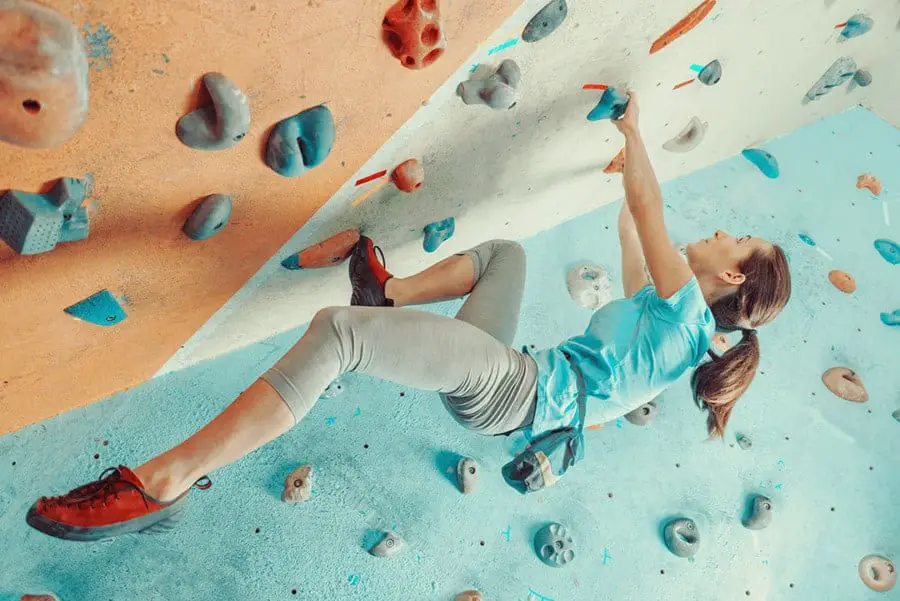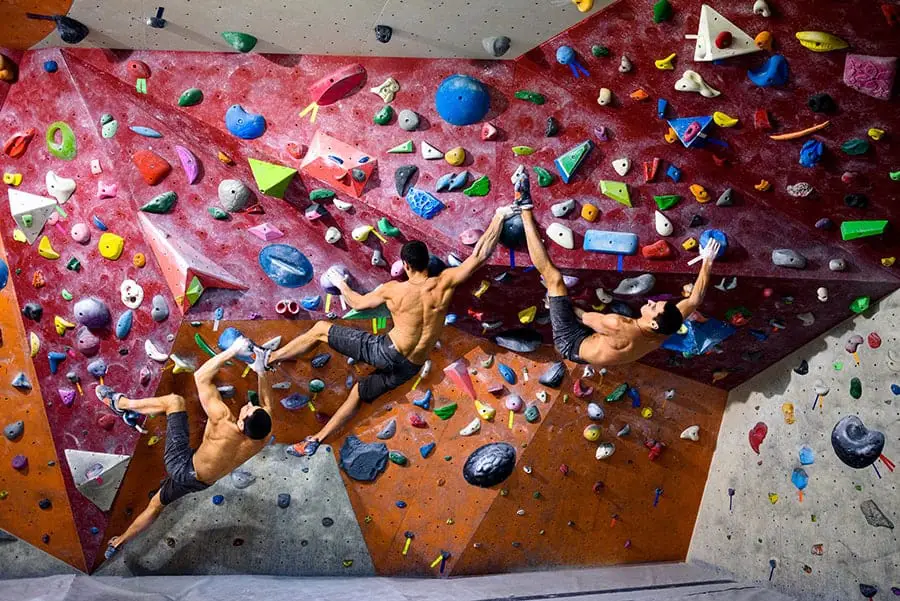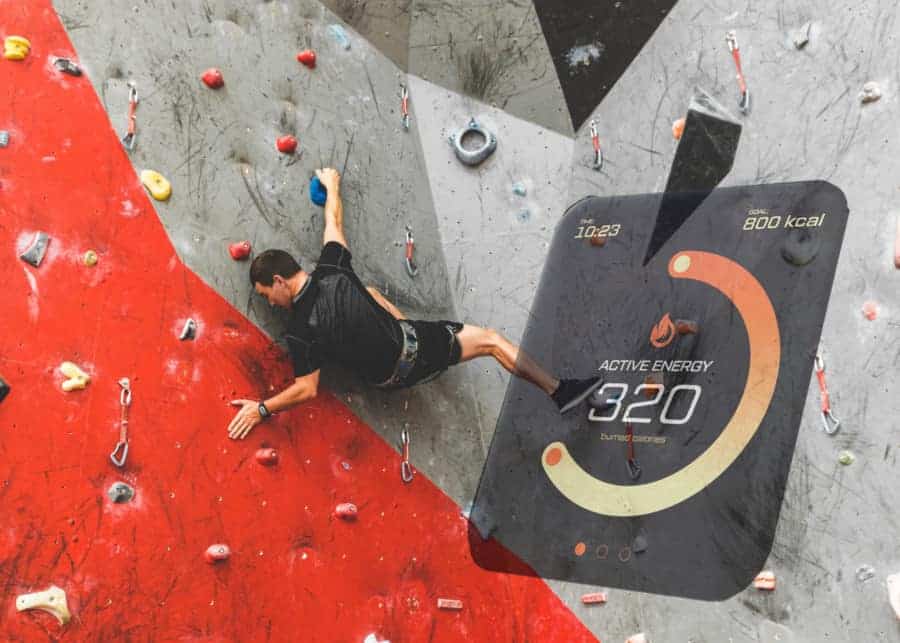One of the reasons I got into gym climbing in college was that I was bored at the traditional gym and wanted to find a way to stay active while having fun. If you’re looking for an exciting way to stay fit without the monotony of traditional gyms, climbing might be the perfect solution.
Combining physical challenge with mental engagement, climbing offers a full-body workout that keeps you active and motivated.
When I first stepped into a climbing gym, I was immediately hooked. The vibrant community, the exhilarating challenge of scaling walls, and the sheer joy of reaching the top were unlike anything I had experienced in a traditional gym.
It wasn’t just my personal experience that highlighted the benefits of climbing; research shows that this activity provides a comprehensive workout that improves strength, flexibility, and mental focus. Let’s explore the main reasons why climbing is the perfect workout for those who seek an engaging and effective fitness routine.

Full-Body Workout: The Comprehensive Benefits of Rock Climbing
Rock climbing offers a unique combination of physical and mental benefits that set it apart from traditional workouts. When I first tried climbing, I was struck by how it engaged my entire body.
Every climb demanded strength, flexibility, and endurance, from gripping tiny holds to balancing on narrow ledges. It wasn’t just a workout; it was a full-body challenge that left me feeling accomplished and exhilarated.
This holistic physical engagement is backed by research. Studies show that rock climbing improves muscular strength and endurance, particularly in the core, upper body, and legs.
Additionally, the dynamic movements required in climbing enhance flexibility and coordination, contributing to overall physical fitness.
Beyond the physical perks, climbing also offers significant mental health benefits. Each climb is like a puzzle, requiring strategic thinking and problem-solving skills.
I remember one particular climb where I was stuck halfway up a difficult route. It was only by calming my mind and carefully planning my next moves that I was able to reach the top. This mental aspect of climbing helps improve focus, reduce stress, and boost confidence.
Research supports these experiences, indicating that climbing can lead to reduced symptoms of anxiety and depression, likely due to the combination of physical activity and the meditative, mindful state climbers often enter.
Whether you’re scaling indoor walls or outdoor cliffs, climbing offers a comprehensive workout that benefits both body and mind.
For a deeper dive into the numerous benefits of rock climbing, check out this detailed guide: The Incredible Benefits of Rock Climbing.

Core Strength: How Climbing Can Sculpt Your Abs
One of the most surprising benefits I discovered when I started climbing was how effectively it engaged my core muscles. Unlike traditional ab workouts, which often feel repetitive and isolated, climbing naturally integrates core strength into every movement.
I remember my first time on an overhang route, where the wall jutted outwards, forcing me to rely heavily on my core to keep my body close to the wall. Each time I pulled myself up, I could feel my abs working hard to stabilize and support me.
This isn’t just my personal experience; research supports the core-strengthening benefits of climbing. Studies have shown that rock climbing significantly activates the rectus abdominis and obliques, the primary muscles responsible for a strong core.
The continuous need to maintain body tension and balance on the wall means that climbers engage these muscles consistently throughout their sessions. This constant engagement helps build not only strength but also endurance in the core, leading to more defined and stronger abdominal muscles over time (MDPI).
Climbing also incorporates dynamic movements that challenge the core in ways traditional exercises often don’t. For example, reaching for distant holds or performing a dynamic move (commonly known as a “dyno”) requires a burst of core power to propel the body upward or sideways.
These varied movements ensure that the core muscles are worked from multiple angles, promoting balanced muscle development and improved functional strength.
For those looking to build a strong, sculpted core without the monotony of crunches and planks, climbing offers an engaging and effective alternative.
If you’re curious to learn more about how climbing can transform your core strength, check out this comprehensive guide: Can Climbing Build Abs?.

Muscle Building: Climbing vs. Weight Training
When I first transitioned from traditional weight training to climbing, I was amazed at how climbing could build muscle in ways that felt more natural and functional. Instead of isolating specific muscles with repetitive exercises like bicep curls or leg presses, climbing engaged multiple muscle groups simultaneously.
Each climb required coordination and strength from my entire body, from the grip in my forearms to the push in my legs and the pull in my back. This full-body engagement not only made my workouts more dynamic but also left me feeling stronger and more balanced.
Research supports the idea that climbing can be an effective muscle-building workout. A study published in the Journal of Sports Sciences found that rock climbing significantly activates major muscle groups, including the latissimus dorsi, biceps, and forearm flexors, which are crucial for upper body strength (BMJ Open Sport & Exercise Medicine).
Additionally, the constant need to stabilize and balance engages the core muscles, contributing to a well-rounded physique. Unlike traditional weight training, which often focuses on isolated muscle groups, climbing promotes functional strength, improving overall body coordination and muscle synergy.
One of the key differences between climbing and traditional weight training is the variety and unpredictability of movements in climbing.
In weight training, exercises are typically linear and repetitive, such as lifting a dumbbell in a fixed path. Climbing, on the other hand, requires navigating routes that are never the same, forcing climbers to adapt and engage different muscle groups with each move.
This variability can lead to improved muscle endurance and a more balanced musculature. A systematic review in the International Journal of Environmental Research and Public Health highlighted that activities like climbing, which involve complex, multi-joint movements, can lead to greater muscle activation compared to traditional exercises (MDPI).
For those who are looking to build muscle but find the repetitive nature of weight training uninspiring, climbing offers an engaging and equally effective alternative.
The challenge of conquering new routes and the thrill of reaching new heights keep the workouts exciting and motivating.
If you’re interested in how climbing can fit into your muscle-building routine, check out this detailed comparison: Can Climbing Build Muscle and Replace Weight Training?.

Calorie Burn: How Effective Is Climbing for Weight Loss?
When I first started climbing, I was looking for a fun way to stay active without the monotony of traditional cardio workouts. To my surprise, climbing not only provided an exhilarating challenge but also helped me burn a significant number of calories.
Each session left me feeling thoroughly worked out, much like a high-intensity interval training session, but with the added benefit of constantly changing scenery and problems to solve.
Research indicates that rock climbing is an excellent way to burn calories and can be highly effective for weight loss.
A study published in the British Journal of Sports Medicine revealed that rock climbing can burn approximately 8-10 calories per minute, depending on the intensity and the climber’s weight (BMJ Open Sport & Exercise Medicine).
This rate is comparable to other high-intensity activities like running and swimming. The combination of strength, endurance, and aerobic exercise in climbing contributes to its high calorie-burning potential.
One of the reasons climbing is so effective at burning calories is its ability to engage multiple muscle groups simultaneously. Each climb involves a combination of pulling, pushing, and stabilizing movements, which increases the metabolic demand on the body.
This full-body engagement ensures that you are not just working out your arms and legs but also your core, back, and even smaller stabilizing muscles.
A systematic review in the International Journal of Environmental Research and Public Health supports this, showing that activities engaging multiple muscle groups tend to have higher energy expenditure compared to those that focus on isolated muscles (MDPI).
Additionally, the variable intensity of climbing—alternating between high bursts of effort and periods of rest while planning your next move—mimics the effects of interval training, known for its efficiency in burning calories.
This variability can lead to an increased afterburn effect, where your body continues to burn calories at an elevated rate even after you’ve finished your climb.
For those looking to lose weight or maintain a healthy weight, climbing offers an engaging and effective solution.
If you’re curious to learn more about how many calories you can burn from climbing, check out this comprehensive guide: How Many Calories Do You Burn From Climbing?.

Cardio Workout: Is Climbing Good for Your Heart?
When I first took up climbing, I noticed my heart rate would spike as I tackled challenging routes, giving me the same cardiovascular rush I experienced during my high-intensity interval training sessions.
The physical exertion required to navigate the wall, combined with the mental focus needed to plan each move, created a unique and intense workout that I found incredibly rewarding.
Research backs up these observations, showing that climbing can significantly benefit cardiovascular health.
According to a study published in the Journal of Sports Sciences, climbing can elevate heart rates to 70-85% of their maximum, which falls within the range of moderate to vigorous physical activity recommended for improving cardiovascular fitness (BMJ Open Sport & Exercise Medicine).
This level of exertion is comparable to activities like running and cycling, making climbing an excellent cardio workout.
One of the key aspects of climbing that enhances cardiovascular fitness is its continuous, varied intensity. Unlike steady-state cardio exercises such as jogging, climbing involves bursts of high-intensity effort followed by short periods of rest as you plan your next move.
This pattern is similar to high-intensity interval training (HIIT), which has been shown to be particularly effective in improving cardiovascular health and endurance.
A review in the International Journal of Environmental Research and Public Health highlights that activities with fluctuating intensities can enhance heart health by improving the efficiency of the cardiovascular system and increasing overall stamina (MDPI).
Moreover, the physical demands of climbing—pulling, pushing, and maintaining balance—require substantial oxygen consumption, which helps improve lung capacity and efficiency. This, in turn, can enhance overall cardiovascular function.
Climbing’s dynamic nature also promotes better blood circulation, contributing to lower blood pressure and a healthier heart.
For those seeking a cardio workout that breaks away from the monotony of traditional exercises, climbing offers an engaging and effective alternative. The combination of physical exertion and mental engagement ensures that your heart gets a robust workout while keeping you motivated and excited.
If you’re interested in exploring the cardiovascular benefits of climbing in more detail, check out this comprehensive guide: Is Climbing and Bouldering Good for Cardio?.


